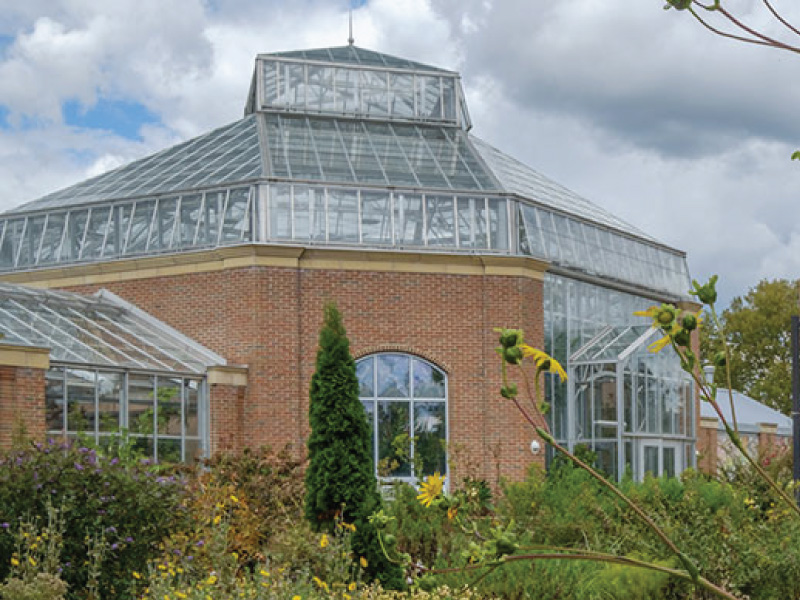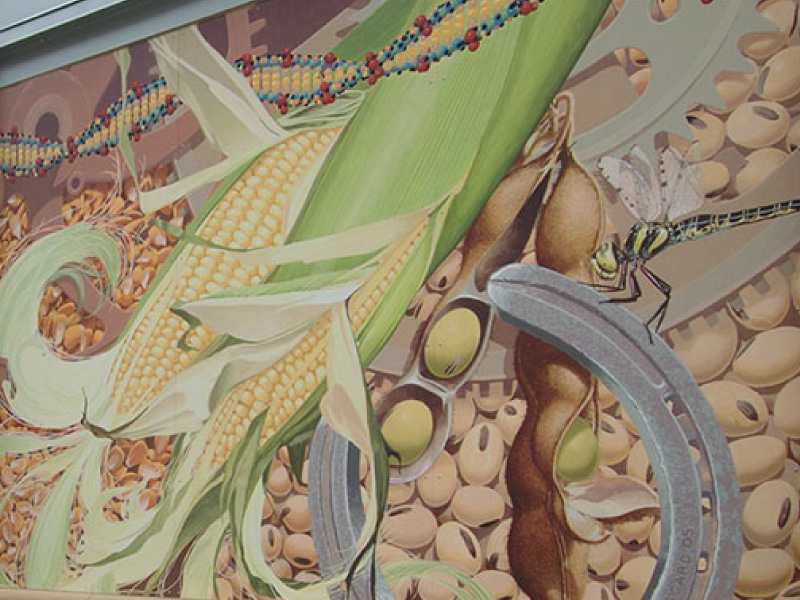Conservatory Architecture and Art
Conservatory Architecture
The Conservatory features many unique architectural design and construction elements, including a unique, hipped octagonal design of the atrium roof. Also unique is the all-aluminum structure integrated into the masonry design and construction.
Visitors and staff step into five different environmental control zones capable of maintaining independent temperatures and humidities for various plant collections or research. One zone is specifically designed for horticultural and botanical research with supplemental lighting and maximized growing plant table area.
With 11,000 square feet of glass installed, The Conservatory has an automatic shade system that can be controlled based on time, temperature, or light influence. Local artist John Maggard created the panels, The Thread of Life, a Botanical History, that adorn the outside of the building.

MURAL
The Thread of Life, a Botanical History, designed by artist John Maggard makes up the facade near the entry way.
Given that the northeast exterior wall of The Conservatory would otherwise be featureless brick, in early discussions with the architectural team in 2004 Prof. Dan Gladish suggested the wall could be covered with monumental art works featuring a natural history theme. He proposed that each of three panels could represent different natural history periods in Ohio and feature typical flora and fauna of each period. The continuity of life could be represented in each by a dragonfly, which has had a 300 million year continuous presence in the area that is now Ohio, and a double-helix of DNA threading through all three panels.
Dr. Gladish proposed that the first panel represent the Carboniferous Period, when much of the region was dominated by swampy estuaries on the coast of a shallow sea, the second the Pre-Columbian Period, the long period of human habitation before the arrival of Europeans to North America, and the third should be today's modern agricultural period. A competition was held among local artists and the work of John Maggard (Miami '76), a Hamilton native, emerged as the top choice. Maggard’s winning imagery, The Thread of Life, a Botanical History was applied to weather resistant panel material using fade-resistant pigments and installed when construction was completed.
Carboniferous plants illustrated prominently in the first panel include a lycopod and a sphenopsid species. Animals include trilobites, aquatic snails, and a cartilaginous fish in the water below and a giant Meganeura dragonfly in the foreground.
In the second panel oak leaves and acorns depict the extensive forests of that time, and indian grass seed heads and a sunflower represent fragments of tallgrass prairie that were known to spot the SW Ohio area. The dragonfly, a shadow darner, can still be found along streams in forested areas.
Corn and soybeans dominate the landscape of SW Ohio today, as depicted in the third panel. A swift river cruiser, a dragonfly that makes long forays over open fields near the rivers it prefers, can be seen perched on some mechanical artifacts of farming.




